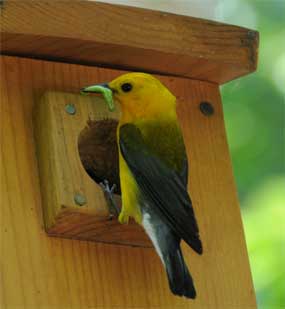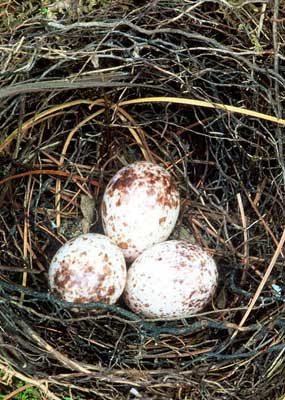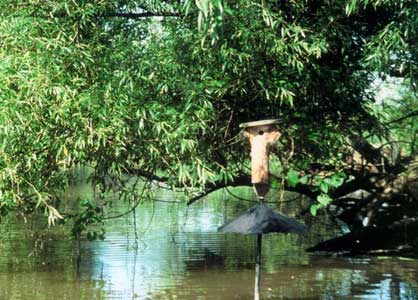
Contents: Species, Interesting Facts, Identification, Song, Distribution, Preferred Nesting Habitat, Diet, Nesting Behavior, Nestboxes, Nestbox Location, Recommended Distance Between Nestboxes, Monitoring, Nesting Timetable, Longevity, Problems, More Info. Also see photos of PROW nests, eggs and young.
Species: The Prothonotary (pronounced proh-THON–uh-ter-ee) Warbler or Golden Swamp Warbler (Protonotaria citrea) or PROW is the only cavity nesting warbler in the eastern U.S. and southwestern Canada. (The other cavity-nesting warbler is Lucy’s Warbler, but its range is restricted to the southwestern United States and western California.)

- May build dummy nests
- The bill color changes: it is blackish during breeding season (March – July) and paler flesh color from August-February.
- A flock of warblers is known as a bouquet, confusion, fall or wrench.
- In spring, migrates earlier than any other North American warbler.
- May nest near swimming pools.
- Both sexes may snap bills when defending nest.
- Females roost in nest cavity, males on a perch in low vegetation or an empty cavity.
- Female usually moves newborn nestlings with all heads pointing towards center of nest.
- Fledglings sometimes land in the water (and can propel themselves across the surface of water for up to 10-15 meters), where they may be eaten by large fish.
- Fledge after only 10-11 days. Parents divide up young and each adult cares for different young.
- Associated with conviction of a spy. Alger Hiss, an amateur ornithologist, denied that he knew a man (Whittaker Chambers) who accused him of being a spy. However, Chambers knew personal details about Hiss, and recounted how excited Hiss had been when he saw a PROW along the Potomac River.
- Over the last 50 years, populations have declined 38% (Rosenberg et al 2016.)
Identification: Fairly large (5.5″ long, 8.75″ wing span per Sibley), brightly colored, heavy bodied with heavy pointed bill. (Darlene Sillick calls them the “golden candle of the swamp.”) Male has brilliant, deep golden/orange-yellow large head, breast and belly; greenish back; plain gray/blue wings (no wing-bars), short, broad gray tail (undertail is mostly white). Large black eye on plain yellow face. Short, dark gray legs on adults. Female is slightly duller, with a yellow crown and nape washed with green. Immature young are similar to adults, but may be more dull, and retrices are more tapered, with brownish legs. In wintering grounds may be confused with Yellow Warblers.
Song: High, clear, metallic with emphatic rising notes twseet twseet twseet twseet twseet (males only during breeding season). Listen to song. May be confused with call of Solitary Sandpiper. Call is a loud, sharp tschip; or quieter, thin tsip.
Distribution: See BBS Map. Breeds in southeastern U.S. Overwinters in mangroves in northern South America, and along Caribbean coast. (Occasionally seen in southern U.S. during winter.) Destruction (logging, agriculture) and degradation of breeding and wintering areas and competition from other birds threaten the warbler’s population, which is declining. They are considered endangered in Canada, with only about 22 nesting pairs in the year 2000.
Preferred Nesting Habitat: PROWs prefer areas with stagnant or slow moving water, especially those that only flood intermittently, such as swamps (especially bald cypress swamps), ponds, wet forested bottomlands, flooded river valleys, and streams with willows, backyard ponds.
Prefers low elevation, flat terrain, shaded forest habitat with sparse understory (BNA). Avoids forests less than 100 hectares in area , and waterways with wooded borders less than 30 hectares wide (Kahl et al 1985).
Diet: PROW eat insects such as butterflies, moths, ants, mayflies, caterpillars, beetles, aquatic insect larvae, spiders, and snails. In nonbreeding season, also eats seeds, fruit, and nectar. May macerate prey like caterpillars or mayflies by whapping them repeatedly against a branch (BNA.)
Nesting Behavior: PROW will aggressively defend nest sites from other cavity nesters. MAY cover eggs when leaving box to protect from predators.
Nestboxes: PROW are secondary cavity nesters, which means they can not excavate their own hole. They nest in natural cavities such as an old downy woodpecker hole, snag, stump or rotten wood in a tree (usually 15-20 cm diameter tree at breast height), or in nestboxes. Apparently they are not very fussy, as nests have been found in a glass jar, mailbox, an enamel coffee pot, coat pockets, cinder blocks, an old hornets nest, a tea cup, pulley on an active river ferry, gourds, tin pail, an electrical breaker box panel, and wooden butterfly hibernation shelters. They will readily nest in a bluebird nestbox if installed in the proper habitat. A 1&1/4″ or 1&1/8″ hole can be used, especially if you want to exclude larger birds like bluebirds.
- BNA says they prefer a larger interior than a standard bluebird box, but Yvonne and Al Bordelon of Little Tchefuncte Hummingbird Hill have had them nest in a small chickadee size box, and Jack Dodson also found they tend to use his smaller nestboxes. Use a small bluebird or chickadee nestbox (4″x4″ floor x 8″ deep) or hollowed out natural tree limb with a 1 2/8 – 1 1/2″ entrance hole.
- Half gallon waxed milk jugs have been used, but only last one season.
- Andy Fondrk and Dan Best of Ohio have been using painted (gray, tan or green enamel) Metamucil containers (7″ deep, 3.5″ diameter) with 1″ plastic screened side vents, and a 0.25″ screened drain hole. PROW actually seem to prefer these over natural cavities. (Bluebird 2001) Note: a source of these containers might be a senior citizen’s center.
- Dick Tuttle uses a nestbox made of 4″ PVC drain pipe, with a long overhanging roof (connected with a bolt and small screw to a PVC cap on top of the tube) made of 11.75″ piece of plastic fence rail (5.5×1.5″) that has three open chambers to insulate the nest from sun. He also places the boxes where they get shade in the afternoon. He mounts the boxes on steel pipes with five foot long sleeves (made of 1.25″ PVC pipe) camouflaged with dark green and brown glossy enamel (slippier for climbing predators.) To raise the nest above flood levels, the sleeve can slide up and down the pipe – it is attached to the pipe with a hose clamp (he saws parallel slots 4″ from the lower end of the sleeve to accommodate the clamp)
- See photo of PROW feeding at an entrance to a cavity in a tree.

Nestbox Location: Nest sites are 2-32 feet above the ground or water, usually under some canopy cover. They may switch nest sites for subsequent broods. Put boxes in shady areas (less sun exposure) within sight of standing or running water, 5 feet above the ground. Boxes can also be mounted 5 feet above the flood stage of water, on free standing channel marker/round steel poles, if you are able to monitor by boat. Preference on orientation of nest hole not clear – may prefer east or west facing.
Recommended distance between nestboxes: Defended breeding territories are about 0.5 to 1.5 hectares ? (BNA), but depend on breeding density and habitat quality.
Monitoring: A number of people say nesting PROWs are very tolerant of humans, and do not abandon their nest even when captured repeatedly at nest for research. Robert Peak sat in lawn chairs at his campsite immediately below the nestbox, and the adults did not seem bothered by his presence at all. Monitoring twice weekly is tolerated. Some websites caution that PROW may be sensitive to human disturbance around the nest site (perhaps pairs that nest farther from humans are more wary), so just in case, use caution during monitoring. Try to monitor on a regular cycle (both day and time), and be as quiet as possible. PROW are inquisitive, and may “monitor the monitor.” The female may sit motionless and silent on nest during monitoring. After hatching and especially close to fledgling, may perform broken-wing display on ground. Young may fledge at 9 days if disturbed.
- Excavation or nest site selection: Arrive late March through mid-May, depending on latitude. Males arrive first. Male picks the nest site before the female arrives, and makes one or more “dummy nests” of fresh moss (1-8 cm deep, may have nest cup). Displays at nest sites for female, repeatedly entering and exiting cavities.
- Nest construction: The female builds the actual nest, which is completed within 6-10 days (BNA says 3.3-8.8 days) (starting third week in April – mid-May). They fill the cavity up to the entrance hole. Nest ID: Mainly mosses and liverwort, plus lichen, rootlets, small twigs and dry leaves, and strips of bark (e.g., grape and cypress), plant down. Usually neatly rounded, cup shaped hollow, smoothly lined with fine grasses and sedges, poison ivy tendrils, leaf stems and skeletonized leaves, fishing line, and feathers. Nest usually built up within 10 cm of entrance hole, regardless of how deep the box is (BNA). Male apparently guards female during nest building and egg laying (BNA). See photo of PROW collecting moss for nest.
- Egg laying: Several days (2-3) delay after nest construction before eggs are laid. Lay 3-8 (rarely 9 – may include eggs of other females?), commonly 4-6, often 7, one egg per day early in morning (4:30-7 a.m.) Clutch sizes are larger in northern part of range. Size 18.47 x 14.55 mm. Eggs: Oval, smooth, somewhat glossy shell, with a creamy or slightly yellow tinge. Boldly and liberally spotted/blotched with dull reddish brown and pale purplish gray spots and splotches over the entire egg. MAY cover eggs when leaving box to protect from predators. Determinate layer (will not replace individual egg lost to predator.)
- Incubation: 12-14 days, usually 13, starting either the day, or the day before the last egg is laid (conflicting reports), only by female. The male often brings the female food during incubation and may inspect nest. The female continues to brood for the first few days after hatching.
- Hatching: Usually happens in midmorning, all eggs usually hatch within 12 hours, sometimes one egg hatches up to 24 hours later. Parents remove eggshells. Typically do not remove unhatched eggs unless they are cracked.
- Development: Altricial (naked) with sparse downy feathers, orangish pink with gray head. Gape red, phalanges yellow. Eyes are closed. Both parents feed young – may feed while perched on entrance. Both parents remove fecal sacs until babies fledge.
- Day 2: young readily lift head to gape if nestbox is tapped.
- Day 3-4: female stops brooding.
- Day 5: mobile, often sit in star pattern facing in different directions from center.
- Day 6: crouch and stay silent when nest is disturbed. Capable of tschip call
- Day 7: can hop and grasp with feet. Shift position in nest often by day 7-8, and may be in a pyramid pattern with all heads pointed towards entrance hole.
- Day 9: can run
- Fledging: 10-11 days old, usually in morning ,usually all fledge within several hours although sometimes one fledges next day. Nearly completely feathered except tail feathers are still half-sheathed. The young are able to “swim” (propel themselves across the water surface) and fly short distances. On one Cornell nestcam, fledging occurred over a 3 hour 30 minutes period.
- Dispersal: Parents feed juveniles up to 35 days after fledging. The parents divide up the young and feed only those, unless the female starts a second brood (in which case the male feeds all young.) Immatures may flock with 3-5 other birds in late June-July.
- Number of broods: Typically two, if first clutch is laid prior to June 15. Sometimes one especially in the north. Reports of females attempting third brood in VA (BNA.) May switch nest sites for subsequent broods, even if first nesting was successful; about 10% of females add more moss and a nest cup over an old nest. Later nests are constructed more quickly than first, typically have fewer eggs (e.g., 4 instead of 5.) If female re-nests, male takes care of all young from first brood.
- Longevity: Oldest record of a banded female is about 8 years (Blem). Average male life span may be about 2.44 years.
- Note: Breeding territory fidelity in a few studies ranged from 57-93%. (BNA)
Problems: About one in four nest attempts fails due to raccoons, black rat snakes, long-tailed weasels or other predators. (Bluebird 2001). House Wrens and Tree Swallows are competitors – in one study wrens destroyed 38% of nests monitored. Tree Swallows usurped 1.5% of nests, but killed adult warblers inside nest cavities on 3 occasions. (Scerbicke et al. 2023, Peer unpubl. data). Mice may also be a problem. Female abandons nest if all eggs are taken by a predator or parasitized by cowbird (BNA.) Many eggs and nests are lost to floods and loss of decayed nest trees. See Predator and Problem ID and Solutions.
- Try to keep the boxes away from overhanging branches or tree trunks flying squirrels could launch from.
- To deter snakes, use a predator guard even over water. A Noel guard may be effective, but install it after the first egg is laid to avoid abandonment.
- House Wrens are major competitors (especially in North where they can cause 33% mortality of eggs and young). Because Carolina and Bewick’s Wrens may nest in similar habitat, they may also compete with or harass PROW, which is unusual since they usually don’t bother other cavity nesters.
- If their nest is parasitized by a cowbird, they may cover the cowbird eggs by building a new floor over them if they have no eggs of their own at the time (Bent). You should probably remove lowered eggs for sanitary reasons (if they break, they will make a mess and attract insects, etc.) A 1.25″ nestbox hole will deter cowbirds (and Tree Swallows.)
- Wasps are also a problem, and they seem to be able to build nests very quickly in a wet environment. (Wasps may prefer boxes with more sun exposure.) Rubbing the inner roof with Ivory (bar) soap several times a year deters wasps from building nests. More.
Acknowledgements: Input from Larry Broadbent, David Gwin, Robert Peak and Charles Bombaci (Hoover Nature Preserve in OH). Nestbox photo by Don Wills of Canada.
References and More Information:
- Photos of PROW nests, eggs and young, Sialis.org
- Video of PROW at nestbox (feeding, removing fecal sacs)
- Nest and Egg ID (with links to species biology and photos of nests, eggs and young) for other small cavity nesters, Sialis.org
- Harrison H.H., Eastern Birds’ Nests, Peterson Field Guide 1975
- Petit, Lisa J. 1999. Prothonotary Warbler (Protonotaria citrea), The Birds of North America Online (A. Poole, Ed.). Ithaca: Cornell Lab of Ornithology; Retrieved from the Birds of North America Online: http:// bna.birds.cornell.edu/bna/species/408 doi:10.2173/bna.408
- The Birdhouse Network
- Cornell PROW nesting sequence from nestcam
- Best of Bluebird_L Classifieds
- Photo with snake in Louisiana by Jill Beckman
- On the Road to Recovery, Ontario Ministry of Natural Resources
- ID, life history, etc. USGS
- The Complete Book of BIRDHOUSE CONSTRUCTION for Woodworkers by Scott D. Campbell, 1984.
- Species at Risk
- Bird of the Month, Smithsonian
- Bluebird Journal (NABS), Spring 2001, Vol.23, No.2
- Abandoned or dummy nests, Sialis.org
- More PROW at nestbox photos by by Yvonne and Al Bordelon of Little Tchefuncte Hummingbird Hill.
- Other photos:
- PROW feeding at an entrance to a cavity in a tree
- PROW at a nestbox affixed to a fifth wheel camper
- PROW collecting moss for nest
- Good photo of PROW (free for use) at Wikimedia Commons
– David Gwin
